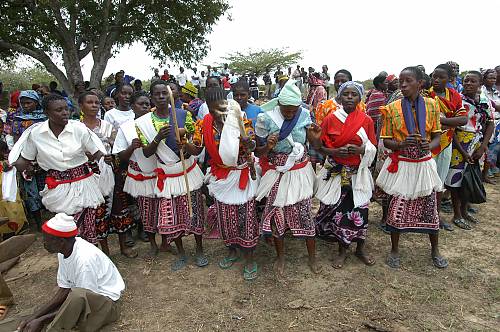The activities that were carried out in the implementation of the project in order to achieve the expected results include;
i.Designing and initiating income-generating activities taking into account the specificities of each Mijikenda community. Sixty-six (66) langstroth beehives, Eighteen (18) catcher boxes, ten (10) smokers, Eight (8) wheel barrows, ten (10) bee suits, twelve (12) pairs of gumboots, six (6) watering cans, twelve (12) hoes, twelve (12) machetes, twelve (12) spades, assorted seeds, assorted honey processing and packaging materials were bought and distributed to six Kaya communities. Experts in tree nurseries and bee-keeping were engaged to assist the communities to establish the projects. The individual woodlots established in homesteads of Kaya elders have reduced dependence on forest resources such as firewood, timber and building poles. Most Kayas have generated income from the sale of honey and seedlings and in turn the same is used to support the enactment of ceremonies and rituals and supplements family incomes.
ii. Young members of the Mijikenda community volunteer to undergo apprenticeship so as to gain knowledge and understanding of the practices as they prepare to become future members of the Council of elders. For example, Kaya Kauma started conducting ceremonies and rituals from 23rd November to 13th December, 2013, aimed at inducting ten young members of the community into the Council of elders.
iii.Reviewing and integrating of information into the national inventory; In December, 2010 the Department of Culture organized a workshop for the Mijikenda communities to sensitize them on community inventorying. The workshop focused on community participation in the identification and inventorying of intangible cultural heritage. Since the inscription of the element, the Department of Culture has been holding frequent meetings with the Mijikenda communities and their council of elders. These meetings have been invaluable in gathering information about the culture of the Mijikenda. The information obtained so far has been used to review and update the National inventory.
iv.Four thousand (4,000) brochures in both English and Kiswahili were printed and distributed to members of the public and stakeholders in order to raise public awareness about the project as well as about the existing information related to the Mijikenda traditions and practices. In addition the Daily Nation newspaper carried out a paid-up newsletter supplement on the Intangible Cultural Heritage of the Mijikenda Kayas.
v.The Department of Culture in collaboration with the Mijikenda communities and other stakeholders organized community cultural festivals and exchange programmes as well as visits to the Kayas by youth. The Inter-community Cultural Festival was held on 8th September 2012 at Kaya Rabai, Bomani village. The festival showcased the greatest assembly of diversity of the traditional dances. Besides the dancing, there were displays of cultural exhibits of the Kaya traditional lifestyles such as making makuti thatches, traditional foods exhibitions and handcrafts. To witness this rare assembly of living culture of the Mijikenda was the Rabai community. Approximately 100 Kaya elders and over 600 community members were in attendance. The festival was graced by the then Permanent Secretary, Ministry of State for National Heritage and Culture, Dr. Jacob Ole Miaron, who was accompanied by the then Director of culture, Mrs. Gladys W. Gatheru (now deceased), UNESCO Programme specialist for Culture, Ms Mulekeni Ngulube, NMK Assistant Director, Coast, and the Rabai District Commissioner, Ms Caroline Nzwili. The inter-community exchange visits was carried out on the 4th and 5th September 2012. It involved Kaya elders, women and youth from Kayas Rabai, Kauma and Duruma visiting each other at their respective Kaya locations. The purpose of the visits was to learn from their peers on how they were progressing with projects, intercultural linkages, cooperation and networks for the promotion of intangible cultural heritage activities related to the Kayas.
vi. In Kaya Rabai and Kaya Duruma, the Councils of elders have been inviting various schools into the Kayas where the elders informally introduce the learners to the traditions and practices of the Mijikenda. Chizini primary school students visited the neighbouring Kaya Duruma while Galana secondary school students from Malindi visited Kaya Mudzimuvya and the Rabai Memorial Museum. This helps to transmit knowledge to the young generation thereby safeguarding the element. A total of about 140 students visited the Kayas.
vii.Carrying out monitoring and evaluation activities at various levels; Monitoring and evaluation is an ongoing process. Since the inception of the project aimed at safeguarding the element, every visit made to the Kaya conducted some monitoring and evaluation to assess the progress so far made. Any shortcomings noted were followed by suggestions on their improvement and way forward.










